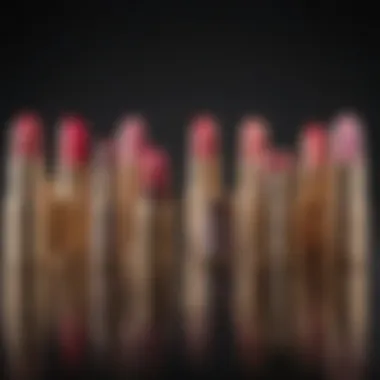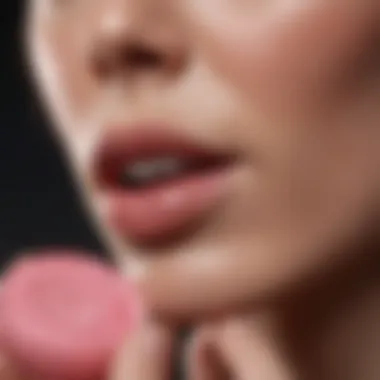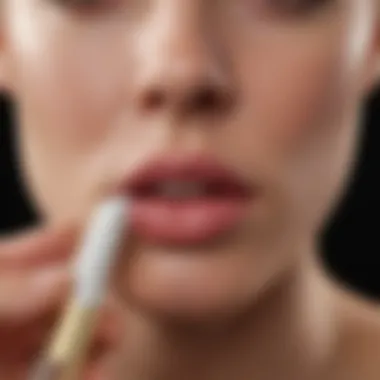Lip Balm Essentials for Chapped and Cut Lips


Intro
Chapped or cut lips can be a source of discomfort, affecting not only appearance but also overall well-being. Understanding the causes of lip damage is crucial to selecting the right lip balm and employing effective care practices. This guide aims to empower women of all ages with knowledge on how to maintain healthy lips, especially during adverse conditions.
Tips and How-Tos
Choosing the Right Lip Balm
Selecting a lip balm involves more than just picking a flavor. Consider the following factors:
- Ingredients: Look for lip balms that contain ingredients like beeswax, shea butter, and coconut oil, which provide moisture.
- SPF Protection: Lips are susceptible to sun damage. Opt for products with SPF to protect against UV rays.
- Avoid Harmful Additives: Steer clear of lip balms with fragrances or artificial colors, as they can irritate sensitive lips.
Application Techniques
The way you apply lip balm can significantly impact its effectiveness. Here are tips to apply lip balm properly:
- Exfoliate: Gently scrub your lips with a soft toothbrush or a sugar scrub before applying balm. This removes dead skin and allows for better absorption.
- Use the Right Amount: A thin layer is sufficient. Over-applying can lead to a sticky feel without added benefits.
- Frequency of Application: Apply balm several times a day, especially after eating or drinking, to maintain moisture levels.
Skincare Routines for Different Skin Types
Your lip care regimen should align with your overall skin type:
- Dry Skin: Heavy-duty balms that contain lanolin are ideal.
- Oily Skin: A lighter formula might work better to avoid clogged pores.
- Sensitive Skin: Look for products marked hypoallergenic and fragrance-free.
Remedies Beyond Lip Balm
Sometimes, lip balm alone is not enough. Here are additional remedies to consider:
- Hydration: Drink plenty of water throughout the day to keep your body, including your lips, hydrated.
- Humidifier: Using a humidifier in dry environments helps maintain moisture in the air, reducing lip dryness.
- Diet: Consuming foods rich in vitamins A, C, and E will benefit your skin health including your lips. Avocado, oranges, and nuts can enhance your overall lip condition.
"A well-rounded approach to lip care not only addresses immediate concerns but also fosters long-term health."
Importance of Regular Care
Consistent lip care is essential. Developing a habit can minimize future damage and enhance lip health in the long run.
Understanding Lip Damage
Understanding lip damage is crucial for several reasons. First, awareness of how lips can be harmed allows individuals to adopt preventive measures. This awareness can improve lip health and prevent discomfort. Second, recognizing the underlying causes and contributing factors helps in choosing appropriate care solutions, including lip balms. Addressing issues of lip damage means not just treating symptoms but also understanding the root causes.
Common Causes of Cut Lips
Cut lips can occur from a variety of situations. One primary cause is physical trauma, which may arise from accidental impacts with sharp objects, such as teeth or utensils. Additionally, habits like biting one’s lips or licking them excessively can lead to cuts and further injury.
Weather conditions also play a significant role. Cold, dry air can lead to chapping. In contrast, exposure to hot and dry conditions can result in cracking. Thus, individuals should be aware of their environments and the impact of such conditions on their lip health.
Environmental Factors Affecting Lips
The environment greatly affects lip health. For example, low humidity levels can lead to moisture loss in the skin. People living in dry climates are more vulnerable to chapped or cracked lips. Furthermore, ultraviolet rays from the sun can damage sensitive lip skin just as it does to the rest of the face. Using a protective balm containing SPF is advisable.
Pollution and irritants in the environment can also cause lip issues. Chemicals from certain lip products may lead to allergic reactions or irritation. Awareness of the surroundings contributes significantly to lip care strategies.


Health Conditions Linked to Lip Damage
Certain health conditions can influence lip health. For instance, conditions like eczema can affect skin elasticity and hydration, leading to cracked lips. Similarly, vitamin deficiencies, particularly in B vitamins and iron, may result in parched and damaged lip skin.
Furthermore, systemic health issues like diabetes or thyroid disorders can hinder the body’s ability to maintain proper moisture levels, leading to dry lips. Recognizing these connections can inform individuals of when it's vital to consult a healthcare professional during persistent issues.
"Understanding the multifaceted causes of lip damage equips individuals with the knowledge to take proactive care of their lips and choose effective treatments."
Combining these elements leads to a comprehensive understanding of the factors causing lip damage, allowing for informed decisions regarding care.
The Role of Lip Balm
Lip balm serves as an essential ally in the quest for optimal lip health. Its primary function is to create a protective barrier, which is crucial for those struggling with chapped or cut lips. Understanding its role goes beyond mere convenience. It directly influences the recovery process and the ongoing health of your lips. Regular use of lip balm can also prevent further damage caused by environmental factors, making it a staple in any lip care routine.
What is Lip Balm?
Lip balm is a topical product designed specifically to moisturize and protect the lips. It typically comes in stick, tube, or pot form, ready for easy application. Key ingredients of lip balms can include natural oils, beeswax, and various vitamins that nourish the delicate skin on our lips.
The formulation is generally designed to mend and soothe the lips, making it vital for those experiencing cuts or dryness. When examining the components, look for options that balance effectiveness and gentleness. Lip balms should not only provide moisture but also additional protection against various environmental aggressors.
How Lip Balm Works on Damaged Lips
The effectiveness of lip balm on damaged lips lies in its blend of emollients, occlusives, and humectants. Emollients work by providing immediate softness, making the lips feel more comfortable. Occlusives like beeswax seal in moisture, essential for maintaining hydration. Humectants, such as glycerin, attract water to the surface of the skin, which provides lasting hydration.
When applied, lip balm forms a protective layer. This barrier helps to guard against wind, cold air, and pollutants that contribute to further irritation. A well-chosen lip balm can also accelerate the healing process of cuts or cracks, ensuring that lips return to their optimal state more swiftly.
Preventive Benefits of Regular Use
Prevention is better than cure, a maxim that holds especially true for lip care. Regular use of lip balm can shield vulnerable lips from damage. It keeps the lips moisturized, making them less susceptible to external factors that cause chapping.
By incorporating lip balm into daily routines, users can stave off the discomfort associated with dry or damaged lips. Here are some notable preventive benefits:
- Hydration Maintenance: Keeps lips consistently moisturized, preventing dryness.
- Barrier Creation: Shields lips from environmental stressors.
- Enhanced Recovery: Supports faster healing of minor cuts or irritations.
Remember that while lip balm is protective, it works best when used as part of an overall lip care strategy. Using it daily, especially in harsh weather conditions, can make a significant difference in long-term lip health.
Key Note: Regular application of a quality lip balm can significantly reduce the likelihood of developing painful cuts or chapping, ensuring lips remain healthy and comfortable.
Choosing the Right Lip Balm
Choosing the right lip balm is critical for maintaining healthy lips. Lip balms vary significantly in their formulations, which means they can offer different benefits. Understanding what to look for and what to avoid can help in selecting a product that not only hydrates but also heals cut lips effectively. Knowledge of key ingredients plays a significant role. Additionally, being mindful of harmful components can safeguard against further irritation or damage.
Key Ingredients to Look For
Natural Oils
Natural oils play a central role in lip moisturization. They act as emollients, helping to soothe and soften the skin. Key oils such as coconut oil and jojoba oil are commonly found in many formulations. These oils are not only hydrating but also rich in fatty acids that promote skin healing. Their natural origin makes them a popular choice among consumers who prefer organic products. However, individuals should ensure there is no allergy to these oils before using them.
Beeswax
Beeswax is renowned for its protective and moisturizing properties. It forms a barrier over the lips, preventing moisture loss while allowing the skin to breathe. Additionally, its natural texture provides a smooth application, enhancing user experience. Being a natural product, it is preferred by those avoiding synthetic ingredients. However, it may not be suitable for vegans or those allergic to bee products, making individual choices necessary.
Vitamins and Antioxidants


Vitamins such as E and C are essential for maintaining skin health. They promote cell regeneration and protect the lips from environmental damage. Antioxidants contribute to repairing and soothing irritated lips, providing an added layer of defense against free radicals. Their inclusion in lip balms can significantly enhance the product’s efficacy. Nonetheless, not all formulations contain adequate amounts of these beneficial ingredients, so checking the label is advisable.
Ingredients to Avoid
Artificial Flavors
Artificial flavors might make lip balms more appealing but often come with drawbacks. These synthetic additives can cause irritation for sensitive skin, negating any benefits of the lip balm. Furthermore, they do not provide any actual therapeutic benefit. Opting for lip balms without these additives is generally a wiser choice for long-term lip health.
Petroleum Products
Many lip products include petroleum substances like petrolatum and mineral oil. While they create a barrier that can prevent moisture loss, they do little in terms of nourishing the lips. More importantly, they can potentially lead to a cycle of dependency, where the lips feel drier, prompting more frequent use without actual improvement. Avoiding these products can be crucial for maintaining natural moisture levels in the lips.
Allergens
Allergens can vary widely among individuals, but certain common ingredients, such as fragrances and certain preservatives, can provoke reactions. Being aware of personal allergies is essential when selecting lip care products. Products labeled hypoallergenic can be helpful, but it is always best to consult a healthcare provider for tailored recommendations if there is a history of sensitivity.
Understanding Labels and Claims
Understanding what to look for on a product's label is equally important. Many brands make claims that may not be backed by evidence. Knowing how to interpret these claims can aid in making informed choices. Key terms like "dermatologist-tested" or "hypoallergenic" can often be misleading. As a consumer, always consider investigating individual ingredients rather than relying solely on marketing phrases.
By being informed about the right choices and key ingredients in lip balm, individuals can effectively address and maintain lip health. This knowledge is vital for everyone seeking a practical approach to lip care.
Effective Application Techniques
Understanding how to properly apply lip balm is crucial for maintaining lip health, especially for those suffering from chapped or cut lips. Proper application can significantly enhance the effectiveness of the product, ensuring that lips receive the moisture and protection they need. This section will outline the best practices for applying lip balm, the recommended frequency of use, and the optimal times to reapply for maximum benefits.
How to Apply Lip Balm Properly
Applying lip balm might seem simple, but there are specific techniques that can optimize its effects. To start, ensure your lips are clean and dry before application. This allows the balm to adhere better to the skin and provides a more effective barrier against environmental factors.
- Choose the Right Amount: Use a small amount of lip balm; a pea-sized amount is usually enough. Too much product can create a greasy feeling and may not absorb well.
- Apply Evenly: Glide the balm across your lips in smooth, even strokes. Avoid harsh rubbing or excessive pressure, as this can aggravate already damaged skin.
- Focus on Problem Areas: Prioritize application to the areas most affected by chapping or cuts. Make sure to cover the corners of the lips, as these spots often get neglected.
- Use Your Finger for Precision: If applying from a pot, consider using a clean finger to manage the amount and ensure even distribution. This avoids direct contact and potential contamination.
Following these steps will help ensure that the balm locks in moisture and provides the protective benefits needed for healing.
Frequency of Application
The frequency with which one should apply lip balm can vary depending on individual lip conditions and environmental factors. However, here are some guidelines:
- General Use: Applying lip balm 2 to 4 times daily is usually adequate for most people.
- Dry Environments: If you are in a dry or windy environment, you may need to apply more frequently. Pay attention to how your lips feel, and adjust accordingly.
- After Eating or Drinking: It is wise to reapply after meals or beverages, as these can wash away lip balm, reducing its effectiveness.
A consistent application routine helps maintain hydrated lips throughout the day.
When to Reapply for Best Results
Knowing when to reapply lip balm is essential for maintaining lip health. Consider the following points:
- Any Signs of Dryness: If your lips begin to feel dry, flaky, or uncomfortable, it is time to reapply. Ignoring dryness can lead to more severe problems, such as cracks.
- Between Activities: If you are active outdoors or engaging in activities that may dry out your lips (like swimming, hiking, or exercising), reapply every 1 to 2 hours.
- Keeping Hydrated: Alongside application of lip balm, ensure you are staying hydrated internally. Nutrition and water intake play a significant role in lip health.
Regular reapplication can prevent chapping and protect against environmental elements.
By following these application strategies, you enhance the efficacy of lip balm, making it a powerful ally against chapped and cut lips. Establishing a routine can make a significant difference, leading to healthier, smoother lips over time.
Alternative Remedies for Lip Health


Exploring alternative remedies for lip health is crucial for those who suffer from cut or chapped lips. While lip balm is a widely accepted solution, incorporating additional treatments can enhance overall lip care. Alternative remedies offer hydration, nourishment, and protection against environmental factors. These options empower individuals to maintain lip health effectively.
Homemade Lip Balms and Treatments
Creating homemade lip balms and treatments is a practical approach that can yield excellent results. The benefits of DIY products include control over ingredients, customization to specific needs, and often a lower cost than commercial products. Here are some common ingredients:
- Coconut Oil: This oil is renowned for its moisturizing properties due to its high fatty acid content.
- Shea Butter: Rich in vitamins A and E, shea butter helps to soothe and nourish the lips.
- Beeswax: It acts as a barrier to lock in moisture while providing a protective layer against external irritants.
To make a simple lip balm at home:
- Combine equal parts of coconut oil and shea butter in a small pot.
- Add beeswax to the mixture.
- Heat gently until melted, then pour into small containers to cool.
This blend can provide effective protection and hydration for damaged lips.
Diet and Hydration for Healthy Lips
The significance of diet and hydration cannot be underestimated in maintaining healthy lips. The body's hydration status directly influences the condition of the lips. Drinking sufficient water is essential. Aim for at least eight glasses a day to keep the skin, including lips, moisturized.
In addition, a balanced diet rich in vitamins and minerals contributes to lip health. Consider including:
- Fruits and Vegetables: Foods high in vitamins A, C, and E can enhance skin health. For example, oranges and spinach are excellent choices.
- Healthy Fats: Incorporating avocado and nuts into the diet can provide essential fatty acids necessary for skin hydration.
Monitoring both dietary intake and hydration can play a significant role in preventing lip damage in the long term.
Professional Treatments and Their Efficacy
For those seeking more advanced options, professional treatments may offer effective solutions for severely chapped or cut lips. Dermatologists can provide tailored advice based on individual conditions. Some professional treatments include:
- Chemical Peels: these treatments can remove dead skin cells and promote new cell growth, making lips appear healthier.
- Microneedling: A procedure that stimulates collagen production, microneedling can improve the overall texture and appearance of the lips.
However, it is crucial to consult a skincare expert to discuss these options and understand potential side effects or recovery times.
Maintaining Long-Term Lip Health
Lip health is often neglected, yet it plays an important role in overall facial appearance and comfort. Maintaining long-term lip health involves understanding both preventative care and responsive measures. The efforts invested in nurturing your lips can lead to better hydration, reduced discomfort, and enhanced aesthetics, making it a worthy aspect of personal self-care.
Daily Care Routine
Establishing a daily care routine for your lips is crucial. This routine can include the following practices:
- Hydration: Drink plenty of water throughout the day. Hydration from within is essential for maintaining plump and healthy lips.
- Consistent Application of Lip Balm: Use a high-quality lip balm regularly, ideally every few hours or after eating and drinking. Look for balms with nourishing ingredients. Applying at night can also be helpful to lock in moisture while you sleep.
- Gentle Exfoliation: Exfoliating lips gently once a week can remove dead skin cells and promote healing. You can use a soft toothbrush or a simple sugar scrub.
Implementing these steps fosters a protective barrier against environmental aggressors and discourages the formation of cracks or cuts. Over time, this routine cultivates resilience in lip tissue.
Adjusting Practices with Seasonal Changes
Lips can react adversely to seasonal changes, necessitating adjustments in your care routine. In winter, lips are exposed to dry, cold air, leading to chapping. Transition to thicker balms containing beeswax or shea butter to create a protective layer. On the other hand, during summer, increased sun exposure can result in sunburned lips. Opt for balms that include SPF protection to shield against harmful UV rays.
Additionally, consider changing your intake of water and foods. Dry climates may require increased water consumption. Fresh fruits and vegetables can also help keep your lips hydrated internally while providing vital nutrients.
Signs of Lip Health Issues and When to Seek Help
Vigilance is key in spotting lip health issues. Common signs indicating potential problems include:
- Chronic Cracking or Bleeding: Persistent issues may signify underlying conditions requiring attention.
- Discoloration or Unusual Changes: Any significant color changes, particularly if they arise suddenly, may necessitate assessment.
- Pain or Swelling: Discomfort that does not subside with common remedies should be evaluated.
Should you notice these signs, consulting a healthcare professional is advisable. Ignoring these indicators may lead to complications, making early intervention important.
Remember: Healthy lips contribute to overall self-care and confidence. Taking the necessary steps will ensure your lips remain soft, smooth, and resilient throughout your life.







